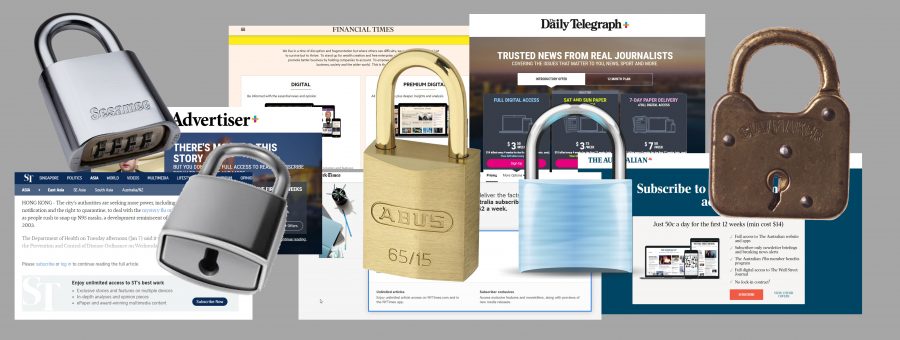The Future of Paywalled News Articles

Shôn Ellerton, January 8, 2020
Clicking on a news link only to find that it lies behind a paywall is frustrating at best, but surely, there’s a better model than the way we’re doing it now.
Have you ever heard of Aaron Swartz? Truth be known, I didn’t until I read Homo Deus by Yuval Noah Harari. Swartz, a computer programmer who helped develop the RSS web feed, Reddit and the Markdown format amongst many of his efforts in the world of IT. He believed in an Internet where information was available to all and for free. One of his activities was to download academic journals from JSTOR, a digital library of academic journals, most of which are inaccessible unless one pays for them, and illegally upload them to be made available to the public. He was arrested by the MIT Police (yes, I kid you not, MIT has a police unit), arraigned and found guilty of several counts of computer and wire fraud. He was not out to hack for money but rather to
“use his prodigious skills as a programmer and technologist not to enrich himself but to make the Internet and the world a fairer, better place.”
– to quote Swartz’s family after his tragic death by suicide after he was declared guilty.
After learning a little more about Swartz, I consider him a true hero of the freedom of the Internet.
This serves as an intro to discuss the issue of the increasing popularity of paywalled news services. Most of these comprise of those lumbering big-company newspaper outlets struggling to survive in a world of freely accessible news; a world where newspapers are under threat near to the brink of extinction. Large-scale outfits like the New York Times, the Economist, the Australian, all the way down to local popular newspapers such as Adelaide’s The Advertiser have adopted a paywalled solution so that only readers with a subscription are able to access their material. Or, at least, most of it. All of them offer the occasional free article but it serves as an enticement to subscribe in full.
But it’s becoming a bit of a problem. Companies that rely on journalism need to survive somehow. Offering free content isn’t going to pay for the bills and put food on the table for those working for them. Perhaps advertising will; however, I’ve read up on the profitability of advertising on websites and make the conclusion that it is becoming an increasingly difficult model to fully depend on. Free-to-view news sources featuring amateur journalists (I mean amateur in that they are not paid) are now the mainstay for many on the Internet scouring for sources of free news. And frankly, I personally believe the quality of some of these free news services are as good or better than the incumbent heavyweights of the news media world.
What are the problems? Are there any solutions? Do we need to change the way we think about pay-walling news articles?
Links to paywalled articles in social media posts
Social media posts featuring a link to an article behind a paywall is becoming a very big problem. Many who post these links may not even be aware that the article is behind a paywall because so many readers never click on the article to read it but rather, to formulate an opinion and respond to the post’s snippet or headline. In cases like this, I often write a comment stating that the link to the post is behind a paywall and ask if there is an alternative source available. It’s not meant to be a derisory comment but rather one to indicate that the material is not available for reading without a subscription.
Those who are aware that they are posting articles behind paywalls often leave an extract from the article from whence readers are invited to comment. Anyone with a sense of rational thought and logic will declare this as dangerous practice. Omitting information or not presenting information in its entirety often leads to completely differing contexts and outcomes of what the article is meant to portray.
You can’t subscribe to everything
A chap by the name of Caleb Bond, a columnist for Adelaide’s Advertiser, regularly tweets on current affairs often linking a paywalled article in the tweet. I was enticed by the subject of the tweet and replied to him that I could not access the article. His response was that subscribing to The Advertiser is not expensive at all and suggested I do so. That’s all well and good but if you want to sample news from several paywalled sources, it’s going to turn out to be a very expensive affair.
Most who do subscribe to paywalled news services select maybe one or two of their favourites. For example, a friend of mine who works in Singapore subscribes to The Economist, but nothing else. Others may subscribe to their local or national newspapers. Most of us, nothing at all.
Subscribing to multiple news services is not a financially viable option for many.
Slipping back into the age of newspapers
The growing number of paywalled news sources does make searching for free-to-view news a little more frustrating. For example, when searching for local Adelaide news on the Internet, more often than not, a link to the local newspaper, The Advertiser, will feature in the search results. Being a paid news service, as many outlets are now these days, the whole concept of the Internet as being a free and diverse store of information available to all is reverting to the ways of the traditional newspaper stand. Many readers that subscribe to their favourite news sources are cocooned in to reading only from those.
If my memory serves me well, I don’t remember quite so many paywalled web services as a percentage of the whole ten years ago. All I had to do was to do a quick search and whatever I clicked on seemed to bring me to a news article available to all. However, these days, there are still plenty of free news sources available and, thankfully, there are new ones that sprout from time to time. A couple of my favourites includes the independent news source, The Intercept, and another from a very different perspective, The Moscow Times.
Some of us are more comfortable with the ‘newspaper mentality’ and take comfort with reading material of a familiar format written and edited by those they have formed a bond with over the years. Others take the plunge and mine a specific piece of news from many various sources; something we could not have done before the Internet.
Adverts. We all hate them.
Most of us claim to find adverts especially annoying, particularly those that flash and pop on your screen. However, they are a source of revenue and often, the only way to gain any revenue apart from asking for donations. However, technology to block adverts and technology to counteract blocking adverts has grown into a sizable market. Browsers such as Brave, for example, have it set as default to block adverts as soon as you have it installed. It is becoming increasingly difficult for online news services to rely on adverts alone; hence the move to platform all or some of their material behind paywalls.
There may be a cleverer way of displaying adverts. In short, adverts are blocked by algorithms in the blocking software that detects links to external websites containing the advertising material. One method may be to host the advertising material directly within the website itself. There could be no way for an ad blocker to detect this as the source of the advertising is native to the website. There are complications with this approach unfortunately. Traffic loads may increase considerably, advertiser user stats won’t be available, algorithms to target the readers’ preferences and locality on what advertising material to present would be ineffective and, of course, the mechanism of transferring the information from advertiser to host website may be complicated and insecure. How would the ads be updated and changed, for example?
Adverts which suddenly pop up, move all the time or flash incessantly are terribly distracting; however, I feel that we have less of them than we had, say, ten to fifteen years ago. Advertisers are learning to be a little more subtle and effective in this regard.
Generally, adverts are easy to block, and it is often a continuous battle of technology between ad blockers and measures to counteract them. Even the highly popular Spotify service can be rendered ad free simply by adding a few addresses in the hosts.txt file for PC users!
As an alternative to forced advertising, a favourable option for many is to offer advert-free services for a small subscription fee.
Many paywalled sites can be skirted around
It doesn’t take long to find out how to bypass a paywalled site. For many paywalled sites, it only involves opening a browser in private browsing mode such as ‘incognito mode’ like in Chrome to do so. Other sites are a little more sophisticated and takes a little more technical know-how. News services that rely on paywalls are constantly fighting the battle on preventing ‘unauthorised’ access to their articles. It is not an encouraged practice and, of course, constitutes a form of stealing. However, I highly doubt that the police will come knocking on the door!
Paywalled services encourage pirating
If one is savvy enough, very often, that premium article behind a paywall is probably lurking word-for-word on a website on a server somewhere in the world. Martyrs for the freedom of information, like Swartz mentioned in the beginning of the article, are in plentiful supply and have no hesitation in uploading material for the public to read for free. It is not a desirable outcome and is basically stealing, but facts are facts. Much like the academic journals in JSTOR, if material is hiding behind a paywall, all the more motive for it to be distributed by piracy.
On a personal note. Regarding academic journals, if the university is publicly funded, I am of the opinion they should be made freely available.
Perhaps a solution that will work in the future
The pay-on-demand model could work effectively but requires the adoption of a better way to pay for it. Asking readers to supply credit card details is not going to work. Who’s going to whip out their credit cards to read one article?
Direct debits to your bank through instant services like WeChat or Alipay, both used extensively in China, would be undesirable as well. Although quicker than a credit card, many of us don’t want to create small transactions against a bank account for viewing one article. I am assuming that the price to read one premium article would be very small. There may also be bank transaction fees which would make the price to read one article unattractive.
Here’s a great example of something which could work. Enter Brave, the browser many of us have not heard about. They have adopted the use of cryptocurrency (a dirty word for many) in the form of Basic Attention Tokens (BAT). It is, effectively, blockchain-based digital advertising. It’s too complicated to describe what the BAT ecosystem does in detail but in short, it rewards readers, advertisers and publishers with BAT tokens depending on content that is advertised, reviewed and read. The clever thing is this. If you purchase a store of BAT tokens in your browser. It doesn’t have to be much, say purchase $10 worth. The Brave browser could transfer a portion of that token to the publisher based on a set dollar-amount by the publisher if you want to access to the article. Perhaps it could be as little as $0.02 to read it or a lot more. It’s imperative, of course, that the reader is aware how much it’s going to cost to access it. The beauty is this. It could be adopted throughout so many news services using a paywall today. This type of model is not necessarily new in principle, but this one is in working operation now. It just hasn’t been adopted by any news service I’ve come across yet.
Whatever system is devised, it needs to be universally accepted, cheap and easy to use. The model we are currently adopting for subscribed news services is much akin to what most other subscription models do. For example, the burgeoning SVOD (streaming video on demand) services market like HBO and Netflix. It’s limiting the reader (or viewer in the case of SVOD services) to what’s available on only one platform. Merging services may increase the choice available but this also, unfortunately, creates monopolies which could strangle the growth of others competing in the field, something which most of us do not want.


